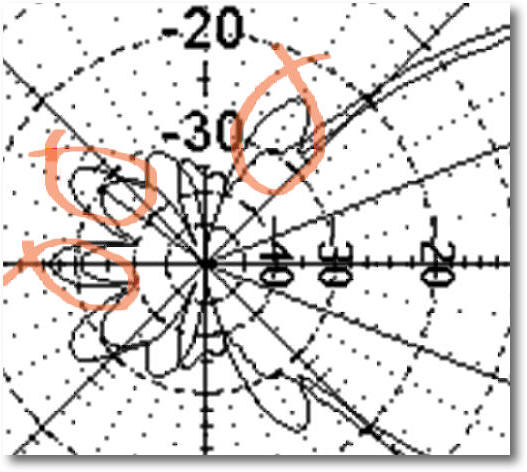An alternative to the 6M7JHV antenna for 6m / 50MHz
Antenna features
Although the forward gain of the LFA2 design discussed here is similar to the 6M7JHV, there are several compelling aspects of the antenna design created by Justin, G0KSC that appeal.
Reduced secondary lobes
Below is a close-in comparison of free space plots of the 6M7JHV and the LFA2 design. The 6M7JHV plot does not include modelling of the M2 T-match assembly.
Take a look at the marked difference in side-lobe suppression - especially the two forward facing ones. On the LFA2 design, the two forward facing side-lobes are virtually non-existent giving a 6dB advantage in the direction of the lobes.
For me, this is the most compelling aspect of the design. My operating bane is local noise coming from all around me. There is nothing that can be done about noise in line with the main forward lobe but this design will hopefully cut the level of noise reaching the receiver from the direction of the secondary forward lobes. A good tactic that is often used to reduce noise coming from the from direction is to turn the antenna a few degrees away from the noise source. This will often reduce the noise and have little impact on the strength of the DX. With these improved lFA2 lobes, this tactic should work even better.
The reduced back lobes that have a 3 or 4 dB advantage over the 6M7JHV are very welcome as well - especially the additional 5.7dB of front-to-back ratio.

Comparing the EZ calculated LFA2 v YO calculated 6M7JHV
Simplified matching
The LFA2 design has a driven element impedance of very near to 50 Ohms. There has much been written about this which can be seen on the Internet and on Justin, G0KSC's web site so I will not go into great detail here. Needless to say, matching the feed cable to the antenna is very simple compared to the T-match and 4:1 balun found on the 6M7JHV. According to Justin, and quite believably so, this could marginally reduce power loss on transmit and improve receive marginally - every bit is useful on EME QSOs!
Bandwidth
If the above isn't enough, the LFA2 design offers the greatest bandwidth of any design available today making it great for both terrestrial DX chasing around 50.110MHz and JT6M EME above 50.200MHz. without suffering SWR degradation as you move up to 50.26MHz. To see the plots go to the alternative 6M7JHV antenna plots page.
So how does the proposed design meet our design wishes out of five?
| Compact design | ||
| Reduced secondary lobes | ||
| Low Q | ||
| Increased bandwidth | ||
| Simple matching | ||
| Easy to make | ||
| Low cost | ||
| Easy to repair | ||
| Reduced sensitivity to static rain | To be determined | |
| British design | ||
| Aesthetically beautiful | They are to me anyway! |